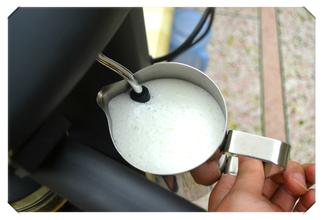The criteria for evaluating a good cup of coffee and the standard description of the taste of the coffee
The essence of the tiebreaker
After the correct picking, preparation and baking, it comes to the last two passes of import, grinding and extraction. These two processes are complementary. The fineness of the powder determines the way coffee is extracted. In general, fine powder is the easiest to extract the essence, so it takes the shortest time, usually with 90 degrees Celsius water quickly after extraction, using Italian machine and mocha pot. Moderately ground words, usually the family drink, to preheat coffee cups and coffee pots, so that the coffee aroma is more prominent, generally 85 degrees Celsius to 90 degrees Celsius water temperature, mainly hand flushing pot, drip pot and siphon pot. As for the coarse powder, it is necessary to use a French pressure pot, which requires the longest extraction time and the water temperature is also between 85 and 90 degrees Celsius.
Good coffee standards.
Although there are a lot of technical terms used to judge coffee, which can be compared to red wine, in fact, they can all be ignored. Your tongue is the first judge. Mr. Liang said that if it is really good coffee, it is actually very simple: it tastes comfortable, clean, no impurities, pure aroma, and the most important thing is that the coffee beans should be fresh. If left for a year and a half, Xi Shi would become a bell without beauty. Just roasted coffee beans, in fact, there is no particularly strong aroma, but after a day there is a difference, that is because, just roasted coffee is issuing internal changes, constantly releasing carbon dioxide outward, carbon dioxide in the exhaust will affect our sense of smell, so temporarily can not smell anything particularly good aroma, so, just roasted coffee is best to put for a while, and then you smell when it is different, The original strong flavor from the African tropical rain forest will make you feel the wild and deep, elusive taste of coffee, without making you want to cook a pot to taste it yourself.
Standard Description of Coffee Taste
Olfaction: Each coffee has a unique aroma (bouquet), which distinguishes different regions or species of coffee. A. Dryaroma/fragrance-dry aroma; coffee ground before brewing B. Cuparoma/aroma-wet aroma; coffee brewed, the aroma emitted by the liquid C. Nose-coffee after the mouth smell of the nose D. Aftertaste-sweet; coffee swallowed, residual taste on the taste buds
dry aroma type: sweet floral, sweet fruity aroma wet aroma type: fruity, herbal aroma nasal aroma: caramel, nutty, wheat aroma after swallowing aroma (aftertaste): carbon (similar to the smell of photocopier documents), chocolate, spices, turpentine/camphor flavor
The intensity of each flavor needs to be further described Rich,Full,Rounded,Flat and the corresponding detailed description. Complexity is different from clutter. Complexity refers to the synthesis of good qualities in coffee, while impurities refer to unpleasant tastes in coffee, such as coke, wood (old beans), grass (new beans), even rubber, or iodine.
2. Gestation: Taste evaluation is for the taste of water soluble substances in coffee. Contains organic (e. g. carbohydrates/sugars, vegetable oils, fruit acids, etc.); tastes range from slightly sweet to extremely sour. Organic compounds include alkaloids (e. g., caffeine, esters) and non-organic substances that cause bitterness. Nonorganic substances include mineral salts that contribute to saltiness and may contribute to sweet to astringent, soapy to metallic tastes. Basic taste sensations include sour, sweet, bitter and salty. During the coffee cupping, bitterness functions only as a supplementary or reinforcing description of the other three tastes when tasting medium and light roast coffee, but it becomes the primary taste description when evaluating dark roast coffee. Bitterness is one of the unpleasant sensations. But sometimes bitterness can be a sensory plus. Bitter but delicious foods include dark chocolate, beer, and grapefruit. The disappearance of bitterness will lower the appreciation of practice. Although proper bitterness can make the taste balance of dark roast coffee, it is worth noting that when bitterness produces residual phenomenon in the root of the tongue, that is, bitterness can not disappear with swallowing action, this bitterness usually causes extreme disgust on the sensory, so it can be used as an index to judge the appropriateness of bitterness. The value of sourness is polarized in the mass market as well as in the boutique coffee player market. Acidity is one of coffee's existing taste, if it can be handled well, it can increase the taste hierarchy and enhance the taste value. Coffee known for its acidity includes sweet potato coffee (sharp as razor) and mocha coffee, such as lemon-flavored and sour yerba sherbet.
3. Mouthfeel: basically refers to the tactile sensation on the palate. Generally speaking, sensory organs are located in the tongue, stomach, and soft and hard jaws are a free ending nerve. But when coffee is drunk, these nerve endings sense the consistency and fat of the coffee, and the combined sensation results in a cup of coffee "body" viscosity that is basically related to the amount of solids brewed in the coffee. These substances include unfiltered fiber in coffee. Oiliness is the lipid (liquid oil, solid fat, or wax) in coffee. These substances are present in green coffee beans as oil or fat at room temperature, and are transferred to liquid form during roasting and finally extracted during brewing. Different brewing methods can affect the performance of coffee. Take the taste as an example. If you use a metal filter for hand extraction, the taste will be heavier/thicker than that of filter paper, because of the increase in suspended matter and oil ratio in coffee.

Source: Network
Important Notice :
前街咖啡 FrontStreet Coffee has moved to new addredd:
FrontStreet Coffee Address: 315,Donghua East Road,GuangZhou
Tel:020 38364473
- Prev

A detailed introduction to the establishment, historical origin and current situation of the International Coffee Organization
The International Coffee Organization is an intergovernmental organization founded in London in 1963. It is composed of coffee importers and exporters. The organization is responsible for implementing the International Coffee Convention and is committed to improving the situation of the world coffee industry through international cooperation. Organizational and functional editorial contributions the International Coffee Organization has made a special contribution to the world coffee industry through: (1) organizing regular high-level meetings
- Next

Which kind of milk is better to foam? Semi-automatic how to make delicate milk foam?
There are many kinds of milk on the field, which makes people dazzling. What kind of milk is suitable for making coffee? First of all, we have to figure out how the milk foam is formed! Both cold and hot milk bubbles are small bubbles produced by the air in the milk fat package. Therefore, the stability and amount of milk fat affect the quality and persistence of milk bubbles, many times.
Related
- What is the meaning of lactic acid fermentation with coffee bean treatment?
- How to judge the state of foam by sound?
- How does the latte pull out the unicorn pattern? Come to get for a little trick to improve the flower pull!
- Will flower pulling affect the taste of the latte?
- Do you know the history of coffee?
- The difference between honey treatment and sun washing what is raisin honey treatment?
- What kind of milk can a novice use to make coffee foam to keep the foam longer? The correct method and skills of milking tutorial sharing
- Why do washed coffee beans taste sour? Flavor characteristics of washed Coffee
- Introduction to the skill of how to practice the size and height of water injection around the circle of hand-brewed coffee
- How do beginners practice coffee flower drawing from scratch?

